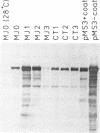Abstract
One of the two mechanisms that regulate expression of the replicase cistron in the single stranded RNA coliphages is translational coupling. This mechanism prevents ribosomes from binding at the start of the replicase cistron unless the upstream coat cistron is being translated. Genetic analysis had identified a maximal region of 132 nucleotides in the coat gene over which ribosomes should pass to activate the replicase start. Subsequent deletion studies in our laboratory had further narrowed down the regulatory region to 12 nucleotides. Here, we identify a long-distance RNA-RNA interaction of 6 base pairs as the basis of the translational polarity. The 3' side of the complementarity region is located in the coat-replicase intercistronic region, some 20 nucleotides before the start codon of the replicase. The 5' side encodes amino acids 31 and 32 of the coat protein. Mutations that disrupt the long-range interaction abolish the translational coupling. Repair of basepairing by second site base substitutions restores translational coupling.
Full text
PDF




Images in this article
Selected References
These references are in PubMed. This may not be the complete list of references from this article.
- Adhin M. R., Avots A., Berzin V., Overbeek G. P., van Duin J. Complete nucleotide sequence of the group I RNA bacteriophage fr. Biochim Biophys Acta. 1990 Aug 27;1050(1-3):104–109. doi: 10.1016/0167-4781(90)90149-v. [DOI] [PubMed] [Google Scholar]
- Alexieva Z., Duvall E. J., Ambulos N. P., Jr, Kim U. J., Lovett P. S. Chloramphenicol induction of cat-86 requires ribosome stalling at a specific site in the leader. Proc Natl Acad Sci U S A. 1988 May;85(9):3057–3061. doi: 10.1073/pnas.85.9.3057. [DOI] [PMC free article] [PubMed] [Google Scholar]
- Berkhout B., Schmidt B. F., van Strien A., van Boom J., van Westrenen J., van Duin J. Lysis gene of bacteriophage MS2 is activated by translation termination at the overlapping coat gene. J Mol Biol. 1987 Jun 5;195(3):517–524. doi: 10.1016/0022-2836(87)90180-x. [DOI] [PubMed] [Google Scholar]
- Berkhout B., van Duin J. Mechanism of translational coupling between coat protein and replicase genes of RNA bacteriophage MS2. Nucleic Acids Res. 1985 Oct 11;13(19):6955–6967. doi: 10.1093/nar/13.19.6955. [DOI] [PMC free article] [PubMed] [Google Scholar]
- Berzin V., Cielens I., Jansone I., Gren E. J. The regulatory region of phage fr replicase cistron. III. Initiation activity of specific fr RNA fragments. Nucleic Acids Res. 1982 Dec 11;10(23):7763–7775. doi: 10.1093/nar/10.23.7763. [DOI] [PMC free article] [PubMed] [Google Scholar]
- Furuse K., Hirashima A., Harigai H., Ando A., Watanabe K., Kurosawa K., Inokuchi Y., Watanabe I. Grouping of RNA coliphages based on analysis of the sizes of their RNAs and proteins. Virology. 1979 Sep;97(2):328–341. doi: 10.1016/0042-6822(79)90344-1. [DOI] [PubMed] [Google Scholar]
- Inokuchi Y., Takahashi R., Hirose T., Inayama S., Jacobson A. B., Hirashima A. The complete nucleotide sequence of the group II RNA coliphage GA. J Biochem. 1986 Apr;99(4):1169–1180. doi: 10.1093/oxfordjournals.jbchem.a135580. [DOI] [PubMed] [Google Scholar]
- Lowary P. T., Uhlenbeck O. C. An RNA mutation that increases the affinity of an RNA-protein interaction. Nucleic Acids Res. 1987 Dec 23;15(24):10483–10493. doi: 10.1093/nar/15.24.10483. [DOI] [PMC free article] [PubMed] [Google Scholar]
- Min Jou W., Haegeman G., Ysebaert M., Fiers W. Nucleotide sequence of the gene coding for the bacteriophage MS2 coat protein. Nature. 1972 May 12;237(5350):82–88. doi: 10.1038/237082a0. [DOI] [PubMed] [Google Scholar]
- Petersen C. Long-range translational coupling in the rplJL-rpoBC operon of Escherichia coli. J Mol Biol. 1989 Mar 20;206(2):323–332. doi: 10.1016/0022-2836(89)90482-8. [DOI] [PubMed] [Google Scholar]
- Remaut E., Stanssens P., Fiers W. Plasmid vectors for high-efficiency expression controlled by the PL promoter of coliphage lambda. Gene. 1981 Oct;15(1):81–93. doi: 10.1016/0378-1119(81)90106-2. [DOI] [PubMed] [Google Scholar]
- Skripkin E. A., Adhin M. R., de Smit M. H., van Duin J. Secondary structure of the central region of bacteriophage MS2 RNA. Conservation and biological significance. J Mol Biol. 1990 Jan 20;211(2):447–463. doi: 10.1016/0022-2836(90)90364-R. [DOI] [PubMed] [Google Scholar]
- Spanjaard R. A., van Dijk M. C., Turion A. J., van Duin J. Expression of the rat interferon-alpha 1 gene in Escherichia coli controlled by the secondary structure of the translation-initiation region. Gene. 1989 Aug 15;80(2):345–351. doi: 10.1016/0378-1119(89)90298-9. [DOI] [PubMed] [Google Scholar]
- Uhlenbeck O. C., Carey J., Romaniuk P. J., Lowary P. T., Beckett D. Interaction of R17 coat protein with its RNA binding site for translational repression. J Biomol Struct Dyn. 1983 Oct;1(2):539–552. doi: 10.1080/07391102.1983.10507460. [DOI] [PubMed] [Google Scholar]
- Wikström P. M., Lind L. K., Berg D. E., Björk G. R. Importance of mRNA folding and start codon accessibility in the expression of genes in a ribosomal protein operon of Escherichia coli. J Mol Biol. 1992 Apr 20;224(4):949–966. doi: 10.1016/0022-2836(92)90462-s. [DOI] [PubMed] [Google Scholar]
- de Smit M. H., van Duin J. Control of prokaryotic translational initiation by mRNA secondary structure. Prog Nucleic Acid Res Mol Biol. 1990;38:1–35. doi: 10.1016/s0079-6603(08)60707-2. [DOI] [PubMed] [Google Scholar]
- de Smit M. H., van Duin J. Secondary structure of the ribosome binding site determines translational efficiency: a quantitative analysis. Proc Natl Acad Sci U S A. 1990 Oct;87(19):7668–7672. doi: 10.1073/pnas.87.19.7668. [DOI] [PMC free article] [PubMed] [Google Scholar]



